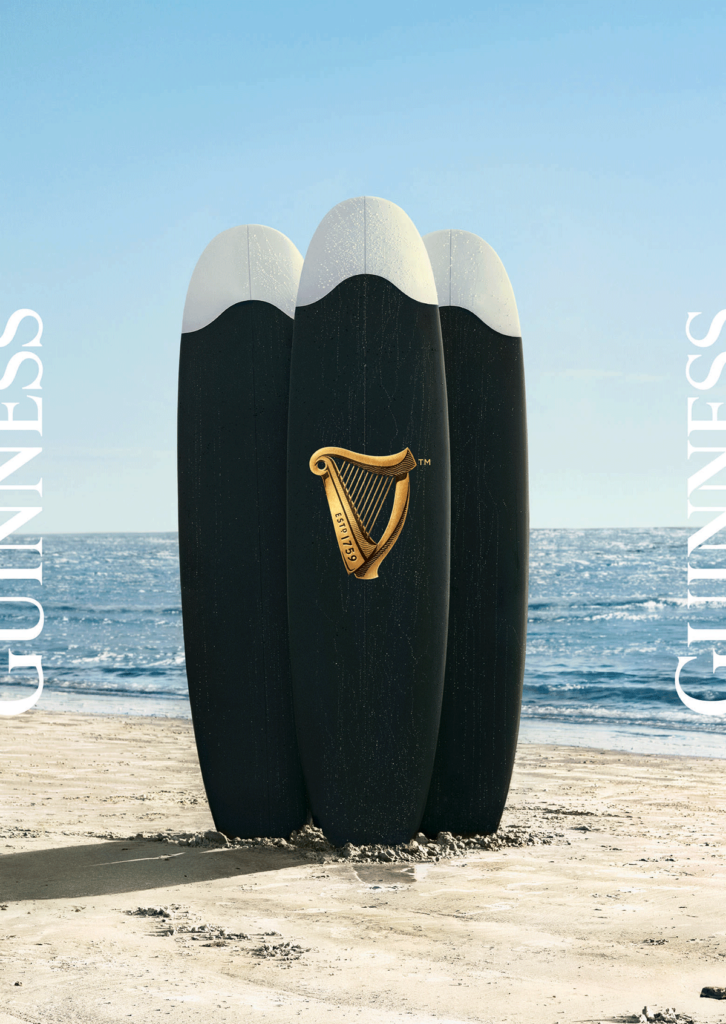When the sun comes out, people’s first instinct might not be to reach for a dark, creamy stout, sometimes seen as a heavier drink more suitable for cold weather. But Guinness, a leader in the stout category, wants to be the go-to at backyard barbecues as much as in cozy pubs.
In the Diageo brand’s summer campaign, which rolled out this week, a pint of the black stuff goes hand in hand with a warm, sunny day. Created by longtime agency AMV BBDO, the ads depict Guinness against blue skies, with friends sipping it at a picnic table—debunking the perception that it is primarily a wintry drink.
With this feel-good marketing, Guinness hopes to build on the success of last summer’s campaign, which resulted in sales of 51.1 million pints in the U.K.—5.6 million more than the same period in 2022. The campaign also helped grow Guinness’s share of on-trade beer sales by 0.9% to 7.2%, the brand’s highest ever share over summer.
Guinness’s summer boost mirrors wider growth in the stout category. The consumption of stout globally increased by 11% between 2021 and 2022, according to drinks market analyst IWSR. This figure was higher in the U.K., one of the largest stout markets, where growth over the period was 23%.
Roisin Vulcheva, head of beer insights at IWSR, told The Guardian in April that this rise in stout partly came from “an expanding consumer base,” especially among women and young people. Experts also attributed the growth to effective marketing from brand leaders like Guinness.
For the past few years, Guinness has been on a mission to change its image as a beverage just for “older, characterful men in pubs” and “make it more relevant to more people on more occasions,” marketing director Anna MacDonald told ADWEEK.
“It wasn’t necessarily a bad image, but it’s not one that everyone can relate to,” she explained. “We had no problem with brand awareness, but many saw Guinness as a brand for ‘people like that.’”
With a different approach, Guinness set out to be a brand for the many.
Reaching overlooked groups
Guinness is already well known for its creative advertising. Its vintage posters are sold as wall art, and commercials like 1999’s “Surfer” are celebrated as some of the best ads of all time.
But while Guinness is one of the most recognizable beer brands in the world, trends such as the craft beer boom in the early 2000s and the rising popularity of premium lager sometimes left stout on the shelf.
“[Guinness] was a strong brand, but growth was stagnant,” MacDonald said.
When MacDonald, a veteran Diageo marketer, moved to the Guinness team in 2020, she saw an opportunity to dust off the pint glass and recruit stout skeptics. Top of her agenda was to begin speaking to an overlooked group in the beer category: women.
“Beer overall is still very male-skewed, and Guinness was skewed even more male,” she said.
When she joined the brand, Guinness was still buying media primarily against a male audience. MacDonald changed that immediately, opening up its media buying to wider demographics.
Guinness also overhauled the gender representation in its ads. Its summer commercial shows a friendship group of mixed genders enjoying the beverage. The brand’s rugby ads have also put female players in the spotlight after it became the first official partner of the Women’s Six Nations in 2019.
Rise of the ‘Guinnfluencer’
Besides women, Guinness has also turned more toward younger audiences.
The importance of young people to the business became evident during recovery from the Covid-19 pandemic. When pubs reopened in the U.K. after lockdown, “it was younger drinkers going back first and in the largest numbers,” said MacDonald.
In May 2021, Guinness launched “Welcome Back,” which playfully highlighted everyday objects and sights, from a white cat lounging on a barrel to seagulls perched on a chimney, that resemble the distinct black and white pint.
This lookalikes concept has continued in subsequent campaigns, such as a summertime ad of a Guinness surfboard.

Since then, Guinness has leaned heavily on social media to fuel conversation and embraced what MacDonald calls the “Guinnfluencer.” This community of diehard fans has helped shape the brand’s creative strategy.
Campaigns such as the lookalikes or “Holding Out for a Zero,” which featured singing faces in frothy pints, were inspired by observations made on social media, MacDonald added.
“[The team at AMV BBDO] pointed out that people identify as Guinness drinkers and use it as a personality definer,” she said. “These advocates for the brand have an audience [on social platforms] that’s really helping us. It means all of that passion is more widely shared.”
Bringing (all) people together
One of the latest growth opportunities for Guinness comes from people who drink little or no alcohol.
Last year on St. Patrick’s Day, one of the biggest days for Guinness, the brand made the unconventional decision to run a responsible drinking campaign promoting its non-alcoholic brew. The campaign took over Ireland during the festivities, including rebranding iconic drinking establishments in Dublin, Galway, Cork and Belfast as Guinness 0.0 pubs.

An ad for the 0.0 beverage is also part of its summer campaign.

“Guinness 0.0 has been a significant driver of growth. The moderation trend is here to stay,” said MacDonald.
No matter how people’s drinking habits change—on the beach or at the pub, imbibing a classic stout or something alcohol-free—MacDonald said Guinness’s most important value has endured through the decades.
“It’s about the power of communion. How that manifests or is dramatized in advertising may change over time based on the world around us,” she said. “But the fundamentals of people coming together and the goodness that brings, remain unchanged.”








